
Hubble

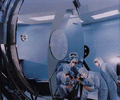 The Primary Mirror
The Primary Mirror
The primary mirror of the Hubble telescope measures 2.4 m (8 ft) in
diameter and weighs about 826 kg (1820 lbs). It is constructed of
ultra-low expansion silica glass and coated with a thin layer of pure
aluminum to reflect visible light. A thinner layer of magnesium
fluoride is layered over the aluminum to prevent oxidation and to
reflect ultraviolet light.
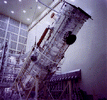 Final Preparations
Final Preparations
Shortly after this image was taken, the Hubble telescope was shipped to
Kennedy Space Center and loaded into the cargo bay of the shuttle
Discovery. The telescope measures 13.1 m (43.5 ft) in length, 4.27 m
(14.0 ft) in diameter, and weighs 11,000 kg (25,500 lb). Note the size
of the workers standing near the base of the telescope. Also note the
orange cylinder attached to the telescope; this is one of the two solar
arrays that provide power to Hubble's batteries. Once unrolled in
orbit, each array will be over 12 m (40 ft) long and provide 1200 watts
of power.
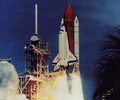 Launch
Launch
The Hubble Space Telescope was first scheduled for launch in 1986. But
due the tragic loss of the shuttle Challenger in late January of that
year, the launch was delayed four years. In April 1990, the Hubble
telescope was lifted into orbit aboard the shuttle Discovery.
 Deployment
Deployment
Crew members aboard the shuttle Discovery shot this photograph April
25, 1990. It shows the deployment of the Hubble Space Telescope from
the payload bay, guided by the shuttle's robotic arm. The giant
spaceborne telescope was put into orbit to collect information about a
large variety of astronomical objects, from neighboring planets and
stars to the most distant galaxies and quasars.
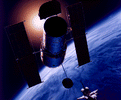 Pointing the HST
Pointing the HST
This artist's concept is a view from near the Hubble telescope, looking
back at the shuttle Discovery shortly after deployment. The telescope's
tracking system is very accurate. The pointing system comprises
reaction wheels that actually move the telescope, gyros that report its
position, star trackers that provide reference points, and the onboard
computer that controls the pointing process.
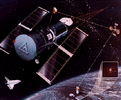 Relaying Data
Relaying Data
The path by which Hubble data arrive on Earth is outlined here. Images
received by the telescope are converted into digital code and radioed
to Earth using high-gain antennas at a rate of one million bits per
second. Once the digital code is received by ground stations, it is
converted into photographs or spectrograph readings for use by
scientists.

 Welcome to the Planets Home Page
Welcome to the Planets Home Page



 The Primary Mirror
The Primary Mirror  Final Preparations
Final Preparations  Launch
Launch  Deployment
Deployment  Pointing the HST
Pointing the HST  Relaying Data
Relaying Data 